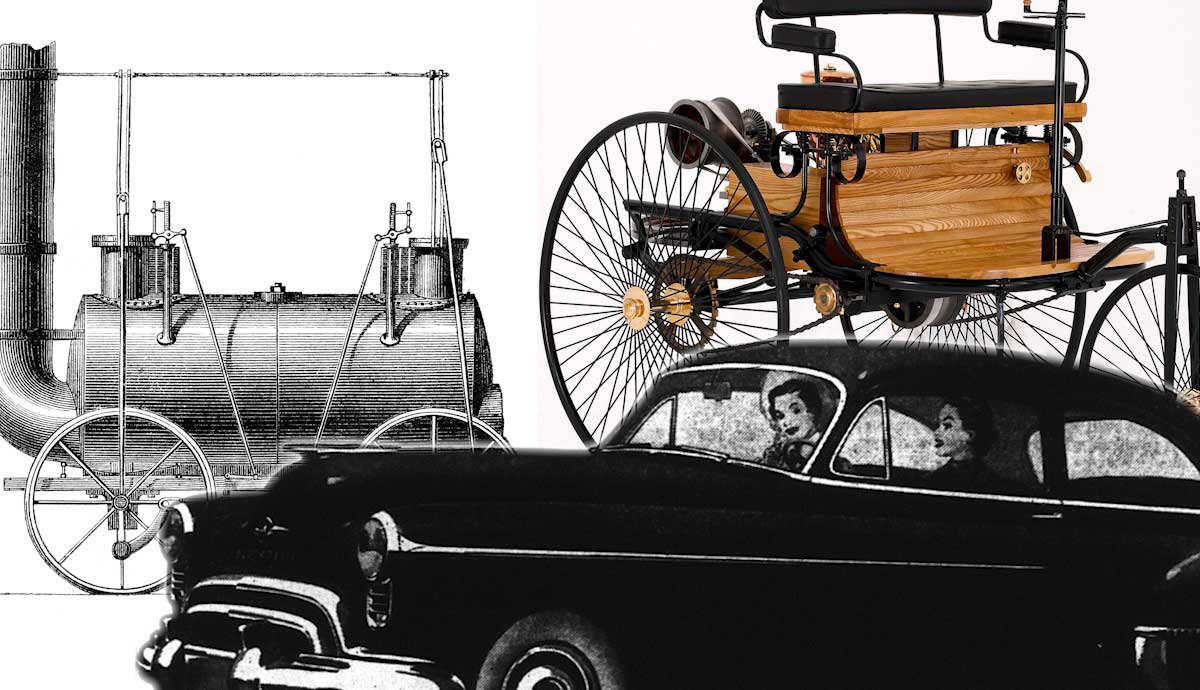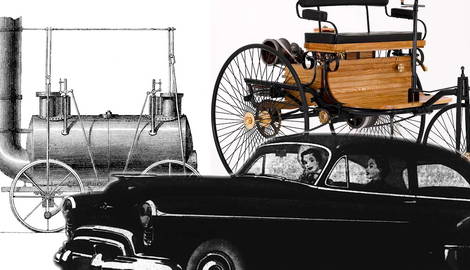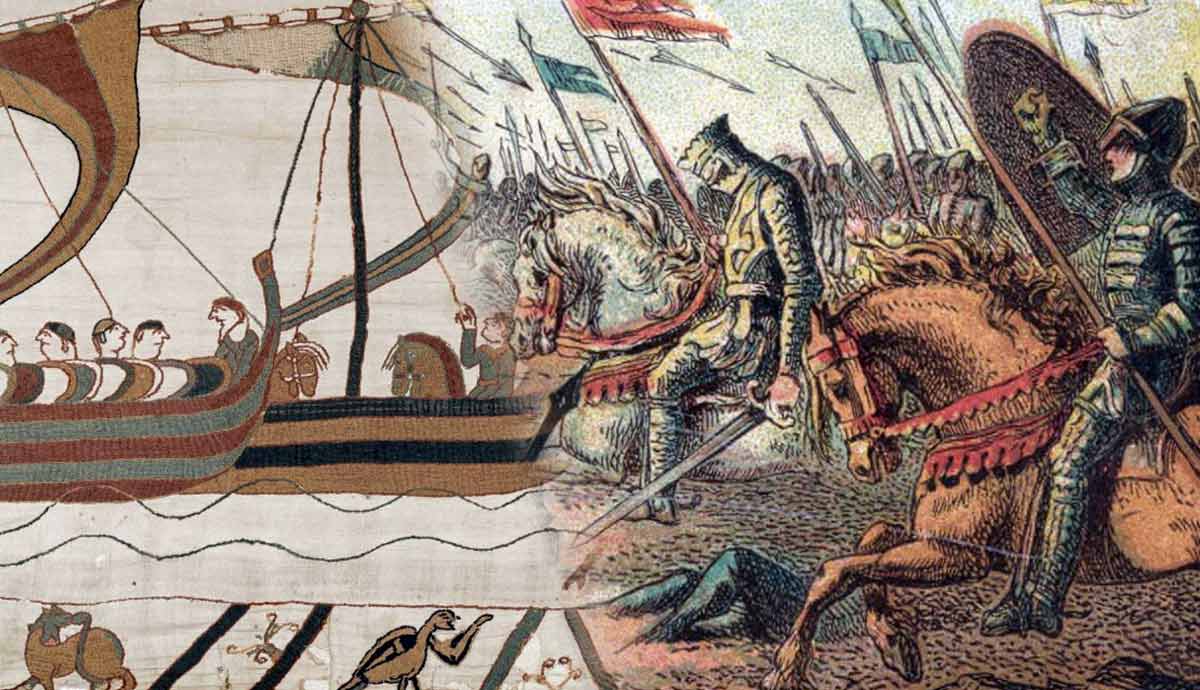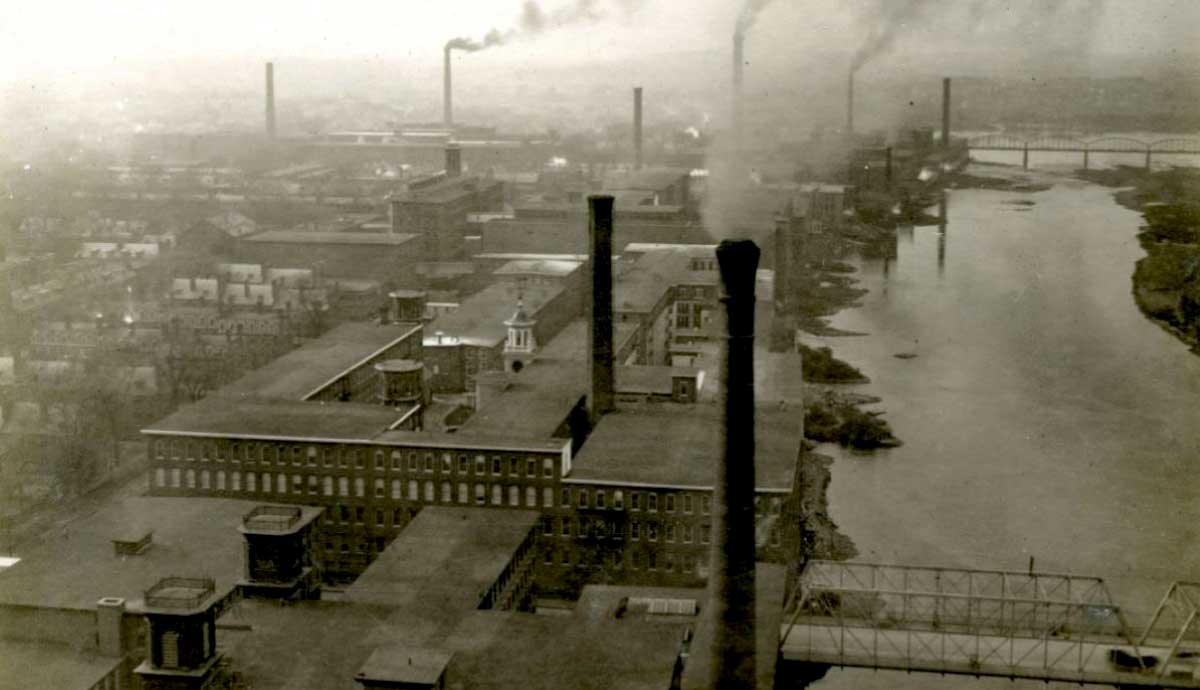
In most developed countries, citizens see many automobiles (cars, trucks, vans, SUVs, buses, etc.) daily. They are considered a sign of industrial development and middle-class socioeconomic status. Automobiles are invaluable tools today, making transportation and economic production far more efficient and adaptable. But when were the first automobiles, powered by internal combustion engines, invented? There are often misconceptions about when the automobile was invented, where it was invented, and who created the first internal combustion engine that continuously turned combustible (explodable) fuel into mechanical energy. From its original inception in 1885, the internal combustion engine, followed immediately by the modern automobile, has changed virtually all societies. Here’s a look at the emergence and evolution of the automobile.
Setting the Stage: Steam-Powered Vehicles

For most of human history, transportation was either on foot or by riding a domesticated equine like a horse or donkey. The Industrial Revolution that began in the mid-1700s developed new technology that slowly revolutionized transportation. The steam engine had become commercially viable in the early 1700s, with coal being used to boil water and generate enough steam pressure to move some sort of wheel. By the late 1700s, the Watt steam engine was powerful enough to be used in factories and is credited with being one of the major innovations of the Industrial Revolution.
In 1802, steam was used to power a wheeled vehicle for the first time in a commercially viable fashion, with the first steam locomotive traveling about two miles per hour (a slow walking pace). A dozen years later, George Stephenson of England built the first practical steam locomotive, which hauled coal. In 1829, he refined his invention with a multi-tube boiler – which allowed high steam pressure to be generated – and could achieve up to 29 miles per hour without a load on the train. Later, this technology was adapted to individual wheeled cars, such as Sylvester Roper’s steam carriages in the United States, but they were not commercially produced.
Setting the Stage: Early Internal Combustion

Steam-powered automobiles existed as curiosities by the late 1800s, but were individual inventions rather than commercially produced goods that were intended for sale. Unfortunately, steam power was not sufficient to reliably move individual vehicles. Gasoline, which could combust, could be used to make far more powerful engines in a much smaller size. In 1861, German engineer Nicolaus Otto built the first practical gas engine, which was patented in 1864. By 1872, a factory was built to commercially produce Otto’s engines and was run by later automobile revolutionaries Gottlieb Daimler and Wilhelm Maybach.
Four years later, in 1876, Otto created the modern four-stroke engine where fuel was burned in a piston chamber. However, Otto’s engines were stationary and later development may have been slowed by legal battles over the patents. Otto himself was not interested in trying to adapt his engines for transportation, but factory manager Daimler was. Daimler left the company and took the engine designs with him – aided by the fact that Germany and other nations no longer recognized Otto’s patents as exclusive!
1885: The Internal Combustion Vehicle Engine

Now on their own pursuits, Gottlieb Daimer and Wilhelm Maybach began working on four-stroke engines in 1882. In 1885, the duo built the first transportable gas engine suitable for an automobile. The two-cycle engine was fitted onto a bicycle, creating the first true motorcycle. Daimler’s design was known as the grandfather clock engine and weighed only about 110 pounds, making it light enough to power a vehicle. Patented on April 3, the engine was mated to the bicycle in November and was originally driven by Daimler’s 17-year-old son, Paul.
Daimler’s motorcycle hit an initial top speed of seven miles per hour. Although he is not credited with the world’s first true automobile, which went to fellow German inventor Karl Benz, Daimler is credited with the world’s first four-wheeled automobile, as Benz’ was a three-wheeled vehicle. Ironically, this makes Daimler the inventor of both the first two-wheeled and four-wheeled vehicles powered by internal combustion engines. By 1886, Daimler was rapidly producing gasoline-powered engines for many other vehicle types, including boats and trains.
1886: The First Automobile

Only a few months after Gottlieb Daimler test-drove the world’s first motorcycle, Karl Benz patented the first gas-powered automobile. In July 1886, newspapers reported on the three-wheeled vehicle being driven in public, creating a sensation of the Benz Patent Motor Car, No. 1. Famously, an improved Benz motor car was taken on a long-distance trip in 1888 by Benz’ wife, Bertha, and their two teenage sons. The trip was a major public relations victory for the new technology, as it proved a motor car could be operated over long distances by non-engineers.

Rapidly, both Benz and Daimler made improvements to their inventions. In 1893, Benz patented an improved steering system for four-wheeled automobiles, and Daimler used his impressive contracts to license his vehicles in both France and Britain. Motor cars began being exhibited in France and Britain, proving the superior performance of gasoline engines to steam power. By the early 1900s, the first racing circuits had been developed, with cars produced by Daimler and Benz reaching up to 35 horsepower in 1901. This further excited public opinion and increased demand for new motor cars.
1886-1912: Automobiles for the Wealthy

The successes of Daimler and Benz quickly spawned several automobile companies in both Europe and the United States. However, mass production and mass ownership were still far off; early automobiles were expensive and complex to operate. Only the wealthy could afford horseless carriages, and there was some public resistance to these vehicles that could spook horses. Thus, most early automakers were luxury brands, such as the “Three Ps” – Peerless, Packard, and Pierce-Arrow – in the United States. As the Gilded Age transitioned into the Progressive Era, the automobile was a symbol of extreme wealth.
Early cars also required lots of maintenance, which typically required wealthy owners to have quick and easy access to mechanics. Not until 1907, for instance, did drivers have access to all-rubber tires with non-skid tread, meaning early cars often had poor control on wet and muddy roads. Mass manufacture of automobiles was not attempted until the early 1900s, when Ransom E. Olds began utilizing a stationary assembly line in 1901. This method allowed him to increase production from 425 “Curved Dash” automobiles in 1901 to some 2,500 in 1902, resulting in Olds becoming the largest automobile manufacturer in the United States. Olds’ innovations, including a system of dedicated parts suppliers, slowly began moving auto production toward non-wealthy consumers.
1913: Henry Ford’s Assembly Line

Due to Henry Ford’s worldwide renown, he is often mistaken as the inventor of the automobile. This is certainly not true, though he may be credited with making the automobile affordable to the middle class for the first time. His Model T was a move in that direction in 1908, but it was still relatively expensive at almost $1,000. What made the Model T more affordable, and cemented Henry Ford’s fame, was the invention of the modern assembly line in heavy manufacturing. In 1913, Ford’s new assembly line method was introduced at Ford Motor Company’s Highland Park assembly plant, adapting assembly line methods used in other industries.
Adapting the assembly line to auto manufacturing was a huge success, reducing the time to produce a Model T to only ninety minutes! The moving assembly line, as opposed to Olds’ stationary assembly line, allowed the manufacturing process to be divided into many small, repetitive tasks that could be done by unskilled laborers. This was controversial and was viewed with disdain by skilled craftsmen…but it had the undeniable effect of increasing output and reducing the per-unit price of the automobile. Other automakers quickly adopted the moving assembly line but struggled to catch up to Ford’s dominance.
1908-1927: Ford Model T & the Middle Class

The assembly line supercharged production of Ford’s simple and durable Model T, creating the first true automobile for the middle class. Between its introduction in 1908, when the first customer received a Model T on October 1, and its end of production in 1927, some fifteen million units were manufactured! Thanks to the assembly line, the cost of the simple car fell from over $900 in 1908 to only $260 in 1925, putting it within reach of most American families. From 1914 to 1925, the Model T was famously offered only in black in order to streamline production and keep costs low.
In 1927, Ford replaced the iconic Model T with the more powerful and refined Model A after seeing competitors gain ground with newer models of their own. The economic boom of the Roaring Twenties had given many Americans enough income to reach beyond the simple black Model T and purchase colorful sedans produced by rivals like Chevrolet. Chevrolet quickly responded to the 40-horsepower Model A with a 50-horsepower model, emphasizing a long-running rivalry between the two auto manufacturers. This competition helped force continuous improvement in the auto sector and keep prices low for consumers. Desire for rebelliousness during the Prohibition Era also increased demand for sleeker, higher-powered sedans similar to those used by bootleggers.
1938: Volkswagen KdF-Wagen

While America had the Model T to make car ownership a middle-class commonality, Europe had to wait a few more decades for the Volkswagen. In 1934, the new Nazi government in Germany began supporting Ferdinand Porsche’s proposal for a “German People’s Car,” which could hold four adults and reach a cruising speed of 100 kilometers per hour (roughly 60 miles per hour). Due to the ongoing Great Depression, the Nazi regime wanted to provide stimulus spending to bolster the struggling German economy and ensure the loyalty of the population. Porsche KG began developing the Volkswagen, or “people’s car,” and completed road testing in October 1936. All reports were submitted in January 1937, and in May 193, the government began construction on the Volkswagen Works plant.
The Volkswagen KdF-Wagen debuted in 1939 at the Berlin Motor Show. Plans were for production of up to 1.5 million units annually, providing the German middle class with a ready supply of low-cost automobiles. However, only months after the KdF-Wagen’s debut, Germany invaded Poland on September 1, sparking World War II in Europe. This almost completely ended production of civilian vehicles in Germany, though some production did occur between 1941 and 1944. Unfortunately, Volkswagen used both Soviet prisoner-of-war (P.O.W.) and concentration camp forced labor during World War II to maintain production.
World War II: Jeep and Volkswagen

The tremendous demand for vehicles during World War II by both the US and German militaries led to government support for auto manufacturing. In the United States, the looming clouds of war led the government to solicit bids to produce a highly maneuverable and extremely durable light vehicle in 1940. Three companies combined efforts, with Ford Motor Company ending up doing about half of the manufacturing of the GPW (GP for General Purpose and W for Willys, the designing company). The “Willys Jeep” became an iconic image of the American military during World War II and routinely performed far beyond its specifications. Due to the success of the Jeep during the war, demand for the Willys Jeep remained high among veterans during the following peacetime.
Volkswagen also produced military light vehicles during the war. Despite Germany’s defeat in May 1945, the Volkswagen came back into production at the very end of that year under British oversight as the Type 1, commonly known as the “Beetle.” Originally intended for British military use in Germany, exporting of the Beetle began in 1947. In January 1949, the first exported Beetle arrived in the United States. Thus, the wartime production of both the Willys Jeep and the Volkswagen resulted in continued civilian production after the war, helping expand middle-class vehicle ownership in both America and Europe.
1950s – early 1960s: Economic Boom & Car Culture in America

The 1950s economic boom, influenced by World War II spending, heavily influenced the auto industry in the United States. An era of car culture emerged, frequently merging with early rock and roll to exemplify freedom and exploration. While the Roaring Twenties and the Model T had allowed middle-class families to afford a simple car, the economic boom of the 1950s and early 1960s allowed each adult in the family to afford a vehicle. Cars could now be used for leisure and vacation travel, spawning a new era of drive-in restaurants and entertainment venues.
Pop culture exploring the 1950s and early 1960s often focuses heavily on car culture, with films like Grease (1978) and American Graffiti (1973) highlighting the importance of cruising the strip and drag racing to older teenagers. The construction of the Interstate Highway System, a Cold War project that would allow warplanes to land on every one mile out of five that was built in a straight line, in the late 1950s further increased the dominance of the automobile in American culture, encouraging people to drive long distances. The car became an economic tool, with businesses and towns not easily accessible by car struggling to survive. Travelers and consumers typically only frequented places with convenient parking and access to major roadways.
1950s-1960s: Ease of Driving Improves

With families enjoying more disposable income in the 1950s, auto manufacturers had an incentive to make vehicles easier to drive. One such innovation was the automatic transmission, which eliminated the clutch pedal and manual gearshift. In 1948, Oldsmobile sold the first car with a fully automatic transmission. Improvements in General Motors’ (which includes Oldsmobile) Hydra-Matic transmissions made the drive smoother and reduced the learning curve for new drivers. With more and more Americans moving to the suburbs, people wanted to commute to work in a simple-driving automatic.
Power steering and automatic transmissions increased women’s demand for automobiles. And, as the Baby Boomer generation (1946-64) hit the driving age, demand for automobiles surged further. This massive increase in driving led to government regulations on automobile safety. Beginning in 1966, the National Highway Transportation Safety Administration (NHTSA) began regulating vehicle safety after the passage of the Highway Safety Act. This led to requirements like seatbelts, padded dashboards, and bumpers on passenger vehicles between the mid-1960s and early 1970s. Since then, additional requirements like tire pressure warning lights and backup cameras have become mandatory for any vehicles sold in the United States.
1990s-Present: Electric Car Revolution

Economically, the rapid spread of the gas-powered automobile has been of tremendous benefit to most people. It has allowed consumers and businesses to quickly and conveniently transport goods, supplies, and people in relative safety and comfort. However, it has also led to increased air pollution and other environmental harms caused by the use of fossil fuels and construction of roads, as well as spilled fuels, vehicle accidents, and disposal of damaged and worn-out automobiles. Many have advocated for the replacement of gas-powered vehicles with electric vehicles to protect the environment.
The electric vehicle revolution can be traced back to 1996 when General Motors produced and leased the EV1. This small sedan is the first mass-produced electric car and received positive customer reviews. Although GM decided not to continue with the project after 1999, destroying all returned leased EV1s, companies like Tesla quickly continued the EV (electric vehicle) revolution in the early 2000s. In 2023, there are many EV models for sale, including full-sized pickup trucks, and the market has likely achieved critical mass for continued growth and expansion. How quickly EVs will replace gas-powered vehicles remains to be seen but will likely occur eventually.










